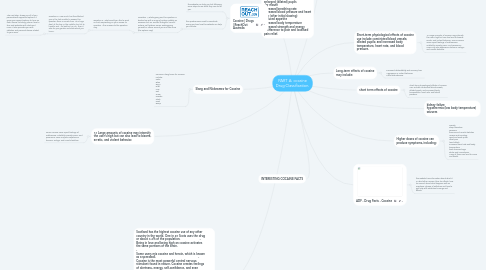PART A: cocaine Drug Classification.
Door Angelique bau


1. Scotland has the highest cocaine use of any other country in the world. One in 40 Scots uses the drug or about 2.4% of the population. - Being in love and being high on cocaine activates the same portions of the brain. - Some users mix cocaine and heroin, which is known as a speedball. - Cocaine is the most powerful central nervous stimulant found in nature. Cocaine creates feelings of alertness, energy, self-confidence, and even power. - Crack Cocaine Fact The name “crack” cocaine comes from the “crackling” sound that is created when impure cocaine is heated - In 1885, a U.S. manufacturer sold cocaine with the promise that cocaine would “make the coward brave, the silent eloquent, and render the sufferer insensitive to pain.” - Inca civilization in the Andes Mountains believed the cocaine was a gift from the gods. - In the early 1900s, white business owners would encourage their African-American employees to cocaine to boost their performance. - Pure cocaine was first extracted from the leaves of the coca plant in 1859 and was marketed in a fortified wine (known as coca wine) in France as early as 1863. - Cocaine was first used in the U.S. in the 1880s, where it was applied as an anesthetic in eye, nose, and throat operations.
2. 16 Large amounts of cocaine may intensify the user’s high but can also lead to bizarre, erratic, and violent behavior.
2.1. Some cocaine users report feelings of restlessness, irritability, anxiety, panic, and paranoia.2 Users may also experience tremors, vertigo, and muscle twitches.
3. Low to moderate doses Some of the effects that may be experienced after taking cocaine include: immediate rush, feelings of euphoria feelings of invincibility a sense of wellbeing increased talkativeness or quiet contemplation and rapture increased confidence and a feeling of invincibility and great physical strength and mental capacity increased libido anxiety, agitation and panic paranoia upredictable violent/aggressive behaviour feeling more awake, reduced need for sleep increased performance on simple tasks enlarged (dilated) pupils dry mouth increased breathing rate increased blood pressure and heart rate (after initial slowing) reduced appetite increased body temperature increased strength and energy indifference to pain and localised pain relief.
4. Slang and Nicknames for Cocaine
4.1. Common slang terms for cocaine include: Coke Blow Big C Dust Line Rail Snow Powder Stash Pearl Bump
5. Cocaine | Drugs | ReachOut Australia
5.1. this website can help you but following some steps to see what they can do for you.
5.2. the questionnaire used to see whats wrong and see how this website can help you include:
5.2.1. Question 1; whats going on? this question is backed up with a range of option suitable as answers such as: suicidal thoughts, harmful actions, self esteem issues, endangering yourself or others around you and lots more (the options vary)
5.2.1.1. Question 2: What would you like to work on first? Depending on your answer to question 1 the answers to this question vary.
5.2.1.1.1. Question 3: How much has this affected you in the last month? to answer this question there is a scale from 'its a huge deal' at the top, in the middle 'its a lot to handle' and ' it's bad but i'm ok'. then it asks for you gender and state which you live in.
